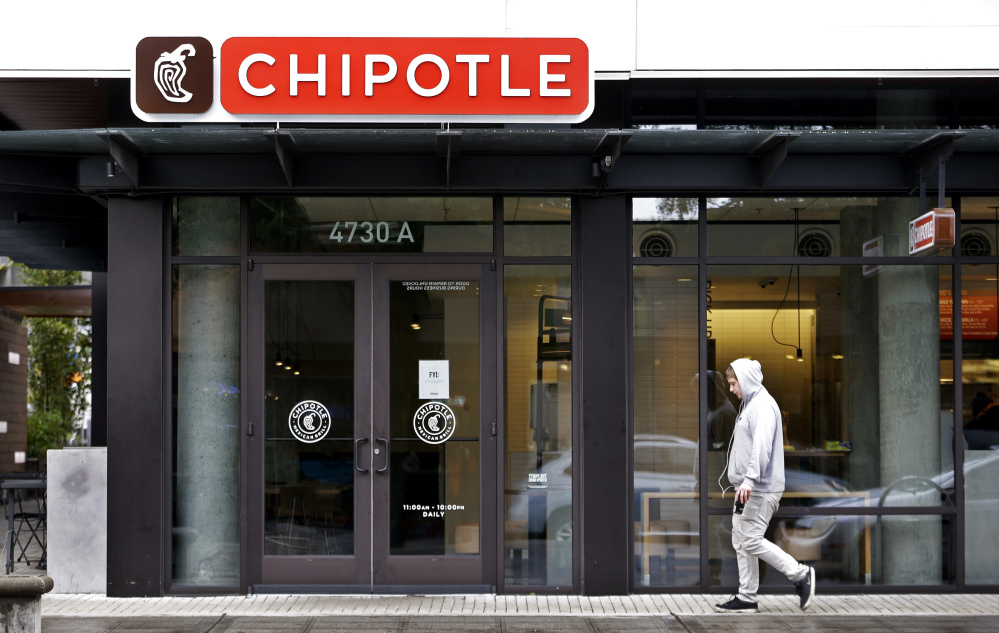WASHINGTON — Major foodborne outbreaks in the United States have more than tripled in the past 20 years, and the germs most frequently implicated are familiar to most Americans: Salmonella, E. coli, and Listeria.
In the most recent five-year period – from 2010 to 2014 –these multistate outbreaks were bigger and deadlier than in years past, causing more than half of all deaths related to contaminated food outbreaks, public health officials said Tuesday. A wide variety of foods were involved, including vegetables, fresh fruits, beef and chicken. Some had never been linked to outbreaks, such as the Listeria-tainted caramel apples that killed seven people and sent 34 to hospitals in late 2014.
Just last weekend, a rash of E. coli cases in Washington state and Oregon prompted Chipotle to temporarily shutter 43 of its restaurants there. No deaths have been reported, but eight people have been hospitalized, according to Washington state health officials. At least 22 cases have been reported across the two states.
The current outbreak follows one involving Salmonella and tomatoes served at Chipotle locations in Minnesota, where more than 60 people reported getting sick in August and September.
DANGERS OF PATHOGENS
In a media briefing Tuesday about the rise in multistate foodborne outbreaks nationally, Kathleen Gensheimer, a senior Food and Drug Administration official in charge of food safety, said the restaurant chain’s executives want to meet with federal health officials to “discuss what practices might be contributing” to the problem.
A new report by the Centers for Disease Control and Prevention makes clear the danger these pathogens pose. In analyzing the illnesses, hospitalizations and deaths from foodborne outbreaks that took place in two or more states between 2010 and 2014, it found 120 multistate outbreaks. Although just a fraction of the more than 4,000 incidents reported during that period, the outbreaks accounted for 34 percent of hospitalizations and 56 percent of deaths.
CDC Director Thomas Frieden said the latest multistate outbreaks are more dangerous because they involve deadlier germs. “They can be big and they can be lethal,” he said during the briefing.
Listeria killed the most people; it was responsible for 57 of the 66 deaths during the five-year period. A single outbreak of contaminated cantaloupe in 2011 killed 33 people.
Imported foods accounted for 18 of the multistate outbreaks. Foods from Mexico, including mangoes and papayas, were the leading source in those events, followed by foods from Turkey such as pine nuts, tahini and pomegranate seeds.
Regardless of an outbreak’s magnitude, the toll can be significant. Contaminated foods sicken an estimated 48 million Americans annually, leading to 128,000 hospitalizations and about 3,000 deaths, the CDC said.
TRACKING THE SOURCE
In September, the FDA finalized long-awaited rules that will require U.S. food manufacturers to make detailed plans to identify and prevent possible contamination risks in their production facilities. The agency said it expects to finalize additional rules soon regarding the growing and packaging of produce, as well as requirements that imported foods meet U.S. safety standards. Most of the rules haven’t been put into place yet.
CDC officials also are using new gene-sequencing tools to track down the source of outbreaks faster. The agency has been using the technology for all investigations involving Listeria since September 2013 and will begin testing it for Salmonella, E. coli and campylobacter next year.
This DNA “fingerprinting” allows public health officials to examine thousands of pieces of DNA to link germs in sick people with the pathogens in contaminated food more precisely than the standard techniques in use for the past two decades. Officials say they’ve been able to solve some “cold cases” by finding contaminated food responsible for unsolved illnesses.
The gene sequencing played a key role last spring in a major incident traced to Blue Bell Creameries, the nation’s third-largest ice cream maker. The company issued the first recall in its 108-year history after ice cream tainted with Listeria monocytogenes was linked to illnesses and three deaths in Kansas and illnesses in Texas.
Send questions/comments to the editors.



Success. Please wait for the page to reload. If the page does not reload within 5 seconds, please refresh the page.
Enter your email and password to access comments.
Hi, to comment on stories you must . This profile is in addition to your subscription and website login.
Already have a commenting profile? .
Invalid username/password.
Please check your email to confirm and complete your registration.
Only subscribers are eligible to post comments. Please subscribe or login first for digital access. Here’s why.
Use the form below to reset your password. When you've submitted your account email, we will send an email with a reset code.